| 1 | There’s over 3900 species |
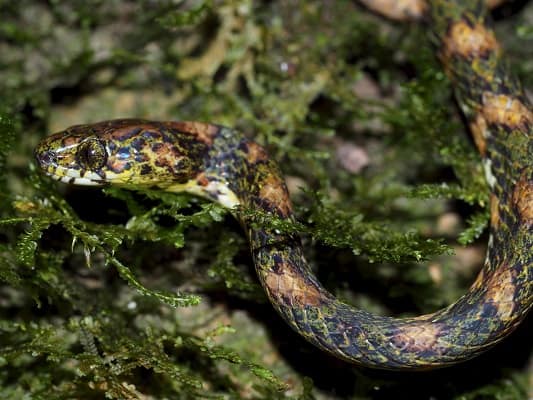
In Florida, it feels like you’re surrounded by snakes, as there’s eastern racers, timber rattlesnakes and eastern coral snakes all potentially living just outside your front door. Yet this represents only a miniscule fraction of the gigantic snake empire worldwide. As of 2023, over 3900 independent species are confirmed to exist, and many more are being furiously debated.
Brazil alone has 412 snake species, while the coral snake family has 82 members. The rattlesnake family is also vast at an estimated 52 species, and then there’s entire families which people haven’t heard of, such as the Erythrolampus snakes of South America, which quietly have 55 members. This isn’t even counting the thousands of extinct prehistoric snakes which we’ll never see.
Some snakes are the sole member of their family, like the king cobra, and then there’s the Sibon snail-eating family with 22 members. Snakes have had millions of years to spiral in bizarre new directions. Their habitats are ever varying, as you can find snakes in coral reefs, by a pristine rainforest waterfall, or warming themselves on the tarmac outside Walmart.
| 2 | …and over 200 are blind |
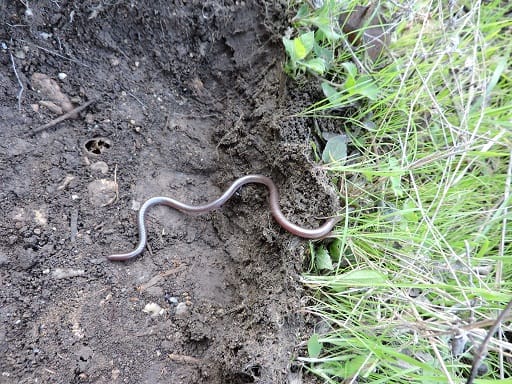
A large chunk of snakes living today chose a subterranean life, meaning that they’re rarely sighted by humans. Instead of leafy branches, their ancestors burrowed downwards into a world of soil, tunnels and twisting roots. Over time, they began feeding on beetles and ant larvae, and their eyes atrophied, turning into minuscule dots that look more like a pen marking. They turned into blind snakes, which now have over 200 species worldwide, divided into over 15 families.
Blind snakes are not fully blind, as they can sense basic changes in light intensity, but only sufficiently to establish whether it’s day or night. They can’t even identify the shape of a predator, let alone a human. Blind snakes are found in every continent (excluding Antarctica) and one of the most common is Brahminy’s blind snake, which loves flowerpots and has been transported all over the world.
As a rule, blind snakes spend the vast majority of their time underground, and only stray to the surface following heavy rainfall. To compensate for their feeble eyesight, their tongue-flecking scent apparatus is highly evolved. A Texas blind snake can detect a couple of stray ants and follow them right back to their anthill capital.
| 3 | Some snakes can fly |
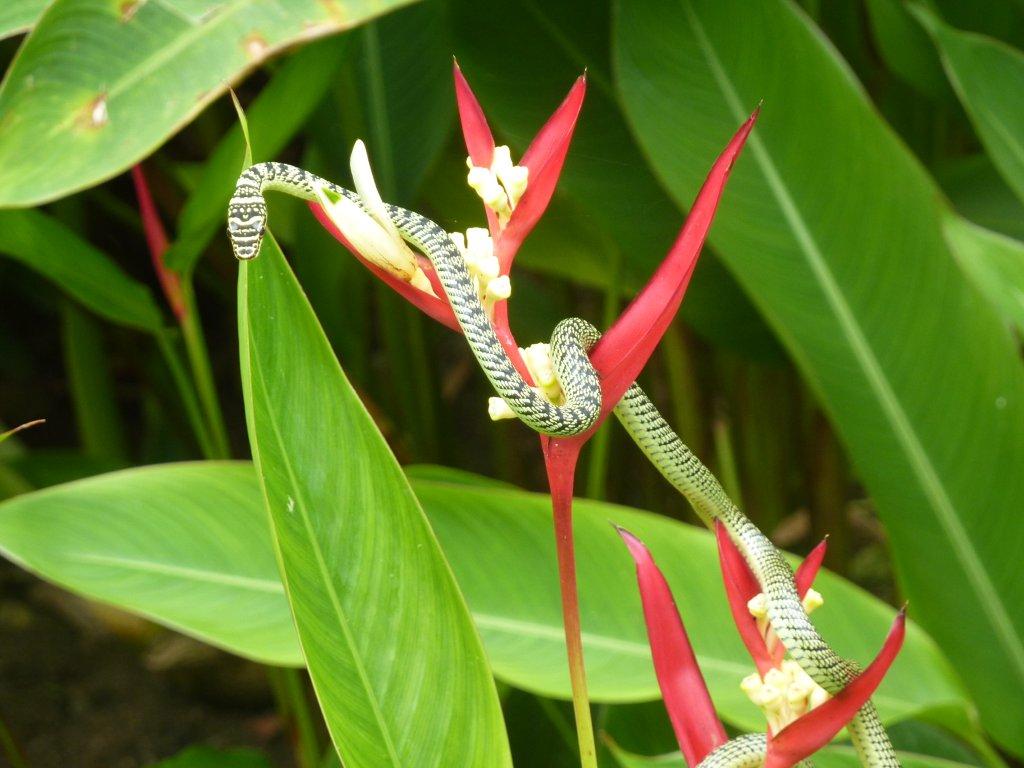
In the forests of southeast Asia, 5 species have evolved one of the freakier abilities yet seen in snakes: flying. The Chrysopelea family lives high in the trees and ranges from India through Thailand all the way to Java, Indonesia. Like a cobra, flying snakes can elongate their ribcage, but with the goal of creating an upside down U-shaped body, which captures air pockets and keeps them afloat.
The most common is the golden flying snake (Chrysopelea ornata), which is everywhere in Thai villages and is about as common as a grey squirrel. This species can glide 5 metres for every 6 metres lost in vertical height, but this pales compared to the paradise flying snake or Singapore, which can reach 100 meters. Somehow, the Chrysopelea family needed a way to cross from branch to branch in their forested world, and gliding was the perfect solution.
This also came with a happy aftereffect of supersharp eyesight, used for spotting lizards on distant branches which they then fly determinedly towards. Flying snakes mainly eat fellow reptiles, one favourite being the Tokay gecko, which looks like a dusty old leather shoe. Landing on people’s heads can and does happen.
| 4 | Others swallow eggs whole |
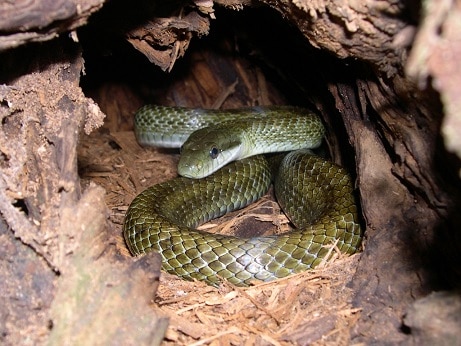
A few hundred snakes worldwide eat eggs, and all the dense nutrition inside, but a select few have taken the practise to the next level. The Japanese ratsnake is abundant all over its namesake nation, and reaches an average of 140cm. While lacking any venom, they possess a modified spine with specially enlarged vertebral shelves, which act as effective puncture instruments.
Japanese ratsnakes eat mammals and birds’ eggs, and the eggs are swallowed whole from the nest. A huge bulge slides down their neck, and then the Japanese ratsnake rearranges itself into 2 coils, and performs a massive contraction. The egg explodes inside their belly, spilling yolk and white everywhere, which begins to digest in seconds.
The Japanese ratsnake then coughs up the shattered fragments of the shell, taking place gradually over the next 4 days. This egg-piercing spine is found in several other ratsnakes, like the four-lined snake of Italy. Unrelated snakes have other special modifications, like the scarlet snake of Florida, which hacks into hard egg shells using a special tooth. The golden yolk dribbles out, which the scarlet snake happily licks up.
| 5 | They’ve learnt how to jump |
Snakes have no legs, even that famous “snake with no legs” fossil from 2015 which turned out to just be a lizard. Yet jumping isn’t beyond snakes, even if it’s more of a nightmarish thrash than a clear bounce. The dog-faced watersnake is one example. This snake lives in muddy tidal flats of India, hanging out in small pools where it swallows fish whole. Dog-faced watersnakes glide through mud effortlessly, coating every inch of their body, but when spooked and needing to flee, they can suddenly leap through the air, advancing several metres at once.
Likewise, the eastern brown snake is the second most venomous snake in Australia. It’s vicious enough as it is, hissing fiercely and coiling menacingly, but eastern brown snakes can also leap off the ground, with nothing propelling them. This has a disturbing twisting motion in mid-air. Check out this bone-chilling video for evidence.
There’s also the checkered keelback of India, found in rice paddies and lakes, which will randomly jump in the air for no reason. As far as we know, snakes can’t jump through your bedroom window quite yet, but there’s still time.
| 6 | Blue snakes are very rare |
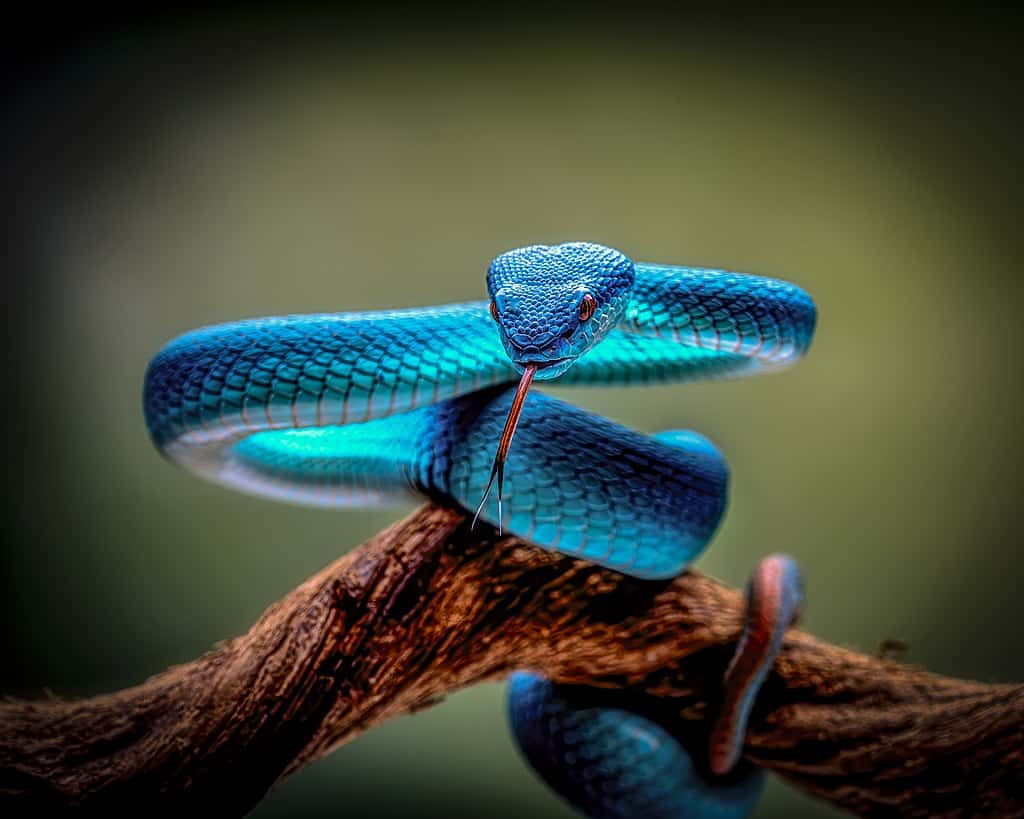
Green snakes might as well be raining from the sky, but a truly blue snake is a surprisingly rare phenomenon. It isn’t rare for a snake to have blue parts of its body, but fully blue is limited to a handful of flukes. The Sunda Islands pitviper is one of the bluest snakes alive. Members of this species can be fully blue with a paler belly, but an equal amount are fully green.
The San Francisco garter snake is a stunning snake with bright blue stripes, which now numbers just two thousand. But most of its body is red and dark grey. In India, you can find the red-tailed ratsnake, a tree dweller which hides in hollows in trunks. It has an amazing blue tongue, but most of its body is green.
Likewise, many Trimeresurus pitvipers have vivid blue stripes, but search for a fully blue snake, where the vast majority of species members are fully blue, and you’ll be searching for a very long time.
| 7 | Around in the dinosaur era |

70 million years ago, reptiles dominated the planet. Ferocious T-rexes stalked the land, reptiles darted between their legs, while herbivorous stegosaurs watched on with amusement. But crocodiles were also around then, little changed compared to today, and so were diverse families of snakes.
Fossils have confirmed this, including a 99 million year old tree snake, found preserved in solidified amber in Myanmar. The snake slithered into sticky tree sap, became stuck, and froze solid, in a similar story to that used to gather dino DNA in Jurassic Park. Perhaps this snake had just escaped the jaws of a pterodactyl.
The best illustration comes from a fossil dated back to 67.5 million years ago, relatively close to the mass extinction. It showed a 3.2 metre snake coiled around a nest of titanosaur eggs, apparently abut to squeeze tightly and feed on the contents. Unfortunately, both snake and eggs were buried in an avalanche of sediment, but fortunately, this perfectly preserved them. In 2015, scientists pushed back the dawn of snakes to 167 million years ago. These proto snakes had jaws which were still unable to fully unhinge, yet more flexible than a lizard, and their heads were already becoming elongated.
| 8 | Common snakes nobody has heard of |
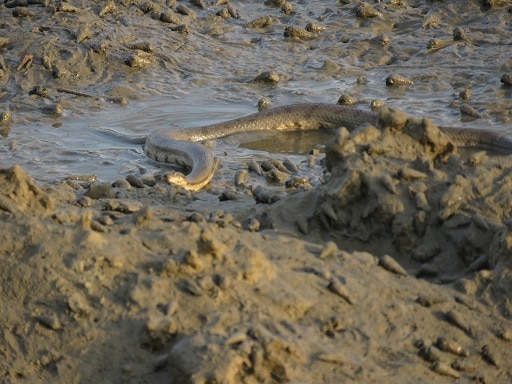
Everyone’s heard of the boa constrictor, and it is indeed one of the world’s most common snake species, inhabiting most of South America. But there’s several dominant snakes which have somehow gone unnoticed, which rule over vast empires in secret and peace. For example, the tiger ratsnake has a colossal range, stretching from central Mexico to southern Brazil. This is a black-yellow snake measuring 2.5 metres, which has a permanent cocky smile on its face. Tiger ratsnakes can climb trees, swim across lakes, eat almost anything and live almost anywhere – the only thing they lack is venom.
Florida is home to the striped crayfish snake, a 50cm species which pokes its head into dark crayfish burrows and gobbles them up. This species numbers up to 1 million in Florida and Georgia, yet they’re shy and stick to their humid waterways, making them a non-factor in the public imagination.
Then there’s the dog-faced watersnake again. This silly-looking snake lives only on muddy coastlines, theoretically limiting their territory. Yet that coastline is so long, stretching from western India to central Thailand, that some estimate the dog-faced watersnake to be one of the world’s most abundant snakes, without anyone really talking about them.
| 9 | Only 2 countries have none |

Whether out of a noble spirit of adventure, or a gradual drift of several miles every ten thousand years, snakes have successfully spread to every corner of the Earth. The obvious exceptions are the Arctic and Antarctic, but Canada has 25 snake species, while the Scandinavian countries are home to grass snakes and adders, the latter being highly cold resistant and officially the world’s most northerly snake.
New Zealand almost qualifies, as it has no native land snakes. But olive sea snakes wash up on beaches along its north shore often enough to cast it out of contention. There are only two countries with zero native snakes, and these are Iceland and Ireland. Iceland is a colossal chunk of condensed and cooled volcanic magma, which was never connected to any major landmass, and is probably too cold anyway.
Fossils prove that Ireland had native grass snakes once upon a time, but for mysterious reasons, they died out, and are now missing from any corner of the Irish island. It’s possible that snakes secretly have a mortal fear of leprechauns, or accidentally swallowed their pot of gold one time and suffered the terrible consequences. Greenland is also snakeless, but not a country. One reason why Ireland and Iceland are snake free is that the Atlantic ocean has no sea snakes, whereas the Pacific ocean has over 30.
| 10 | New snakes constantly discovered |
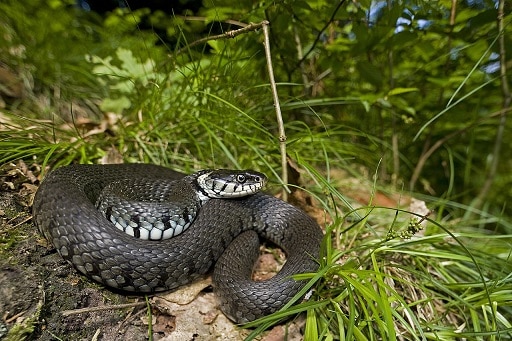
Though 3900 snake species are identified, scientists are herpetologists are far from done yet. In fact, there aren’t enough scientists to deal with all the new discoveries the snake kingdom is throwing at them. Every year, new snake species are identified and added to the tally.
Some are upgraded subspecies, such as Heller’s red-necked keelback, which was split from the main red-necked keelback in 2021. In 2017, the grass snake of Britain became an all-new species, despite being a regular companion of Englishmen for thousands of years. It was now the barred grass snake (Natriix helvetica), genetically distinct from those in Germany and Poland.
A larger number still are completely new discoveries. One was Zug’s odd scaled snake, discovered in 2013 while scientists scoured creeks and creek beds in the jungles of Vietnam. Suddenly, their eyes caught some smooth black scales with a flash of iridescent colours, and an all new snake species measuring 40cm. In 2023, Leonardo DiCaprio had a new snake named after him, although he may have been disappointed to learn that Sibon irmelindicaprioae spends its entire life sucking snails out of shells in an insect-infested rainforest.
